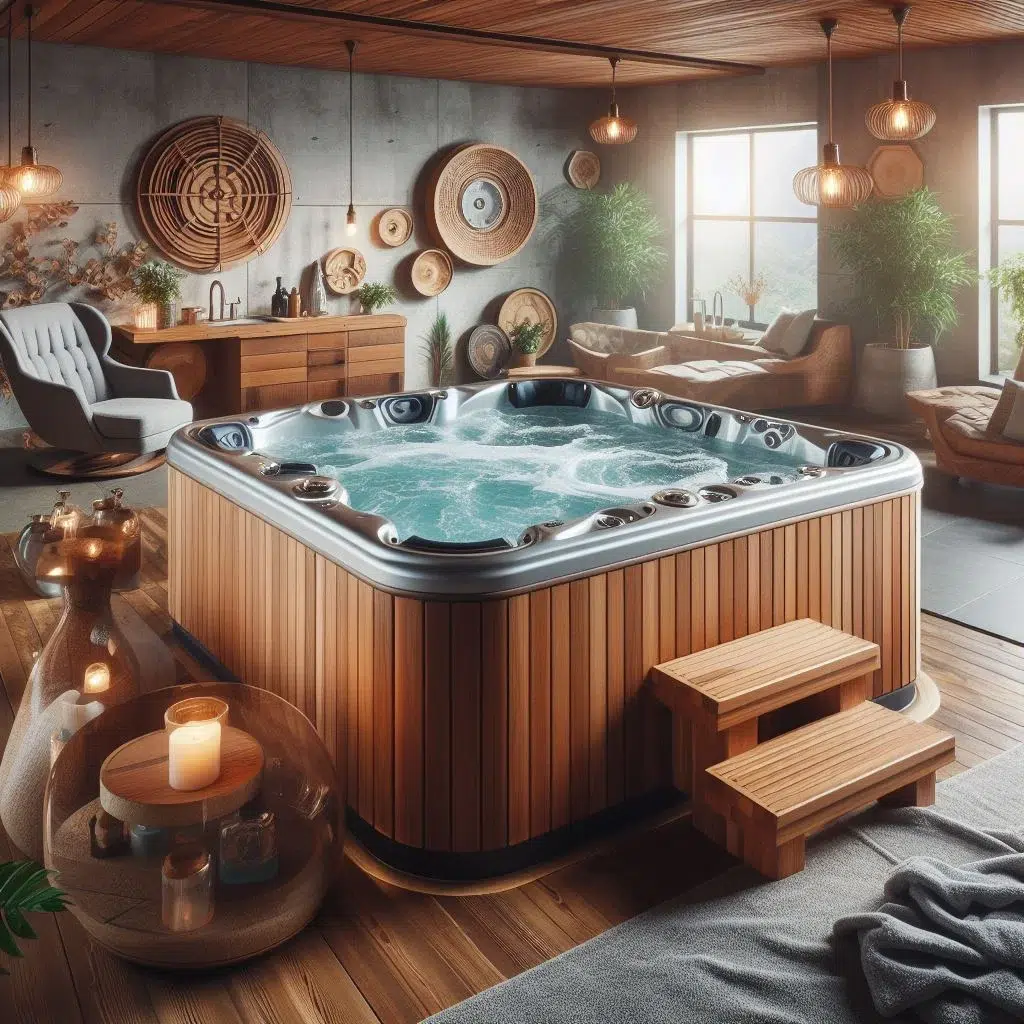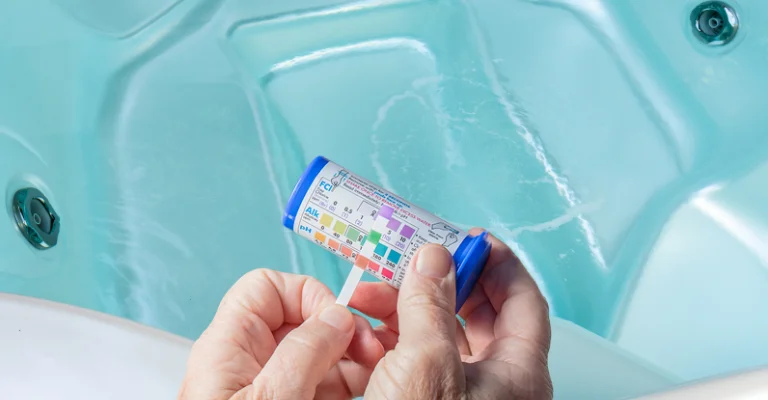7 Benefits of Hot Tubs Made from Natural Materials
Are you looking for a hot tub that is durable, eco-friendly, and health-promoting? Learn how natural materials like wood, stone, and metal can offer a better desirable tub experience. Find out how to get your natural hot tub today and enjoy its many benefits.
Hot tubs can be made from various materials, each with its advantages and disadvantages. Here are 6 common materials used:
- Acrylic: Acrylic is the most popular material for hot tubs. It is strong, durable, and easy to clean. It also has good heat retention and is available in various colors and finishes.
- Fiberglass: Fiberglass is another popular material for hot tubs. It is less expensive than acrylic but less strong and durable. Fiberglass hot tubs are also more susceptible to scratches and cracks.
- Vinyl: Vinyl is the least expensive material for hot tubs. It is also the least durable. Vinyl hot tubs are not as strong as acrylic or fiberglass hot tubs and are more likely to fade in the sun.
- Concrete: Concrete is a very durable material that lasts many years. However, concrete hot tubs are also the most expensive. They also need to be more convenient and more accessible to move.
- Wood: Wood hot tubs are becoming increasingly popular. They are a beautiful and natural addition to any backyard. However, wood hot tubs require more maintenance than other types of hot tubs. They need to be treated regularly to prevent rot and mildew.
- Stainless steel: Stainless steel hot tubs are the most durable type of hot tub. They are also straightforward to clean. However, stainless steel hot tubs are also the most expensive.
The best material for a hot tub is the one that best meets your needs and budget. If you want a durable and easy-to-clean hot tub, acrylic or fiberglass is a good option.
If you are on a budget, vinyl is a good choice. Concrete or stainless steel is a good option if you want a hot tub that will last for many years. And if you are looking for a beautiful and natural hot tub, wood is a good choice.
Why You Should Choose Natural Materials for Your Hot Tub
Hot tubs are a great way to relax, unwind, and enjoy quality time with your loved ones. But did you know that not all hot tubs are created equal? Some hot tubs are made from synthetic materials, such as acrylic, fiberglass, or plastic, which can have drawbacks.
These materials can leach chemicals into the water, fade over time, crack under extreme temperatures, and require more maintenance and cleaning.
On the other hand, some hot tubs are made from natural materials, such as wood, stone, or metal, which can offer some advantages. These materials are more durable, eco-friendly, aesthetically pleasing, and health-promoting.

In this article, I will share with you seven benefits of hot tubs made from natural materials and why you should consider getting one for your home.
1. Durability
Natural materials are more resistant to wear and tear and can last longer than synthetic materials. Wood, for example, can withstand harsh weather conditions, such as rain, snow, and sun, without cracking or fading. Stone and metal can endure high temperatures and pressures without warping or corroding. Natural materials can also retain their shape and structure and do not need to be replaced as often as synthetic materials.
2. Eco-friendliness
Natural materials are more environmentally friendly than synthetic materials, as they are biodegradable, renewable, and recyclable. Wood, for example, can be sourced from sustainably managed forests and composted or reused after its lifespan. Stone and metal can also be recycled or repurposed and do not produce harmful emissions or waste. Natural materials can also reduce energy consumption, as they can retain heat better than synthetic materials and do not need as much electricity or gas to operate.
3. Aesthetics
Natural materials are more attractive and elegant than synthetic materials, as they have a unique texture, color, and grain. Wood, for example, can add a warm and cozy touch to your backyard and blend well with your landscape. Stone and metal can also create a sleek and modern look and contrast nicely with your plants and flowers. Natural materials can also enhance your mood and well-being, as they can evoke a sense of calmness, harmony, and connection with nature.
4. Health
Natural materials are more beneficial for your health than synthetic materials, as they can improve your blood circulation, muscle relaxation, and skin condition. Wood, for example, can release negative ions into the water, boosting your immune system, lowering your blood pressure, and balancing your pH levels. Stone and metal can also emit minerals and trace elements into the water, nourishing your skin, hair, and nails and detoxifying your body. Natural materials can also prevent the growth of bacteria, algae, and mold and do not need as much chlorine or other chemicals to sanitize the water.
5. Customization
Natural materials are more versatile and flexible than synthetic materials, as they can be customized to fit your preferences and needs. Wood, for example, can be carved, stained, or painted in different shapes, sizes, and colors to suit your style and taste. Stone and metal can also be cut, polished, or welded in various designs, patterns, and finishes to match your theme and budget. Natural materials can also be combined with other features, such as jets, lights, speakers, or aromatherapy, to enhance your experience and enjoyment.
6. Value
Natural materials are more valuable and cost-effective than synthetic materials, as they can increase your home’s resale value and save you money in the long run. Wood, for example, can add a rustic and charming appeal to your property and attract more buyers and renters. Stone and metal can also create a luxurious and sophisticated ambiance and impress your guests and visitors. Natural materials can also reduce maintenance and repair costs, as they do not need as much cleaning, painting, or sealing and do not break down or deteriorate as quickly as synthetic materials.
7. Comfort
Natural materials are more comfortable and enjoyable than synthetic materials, providing a smoother and softer surface and a more natural and authentic feel. Wood, for example, can conform to your body’s shape and curves and offer a gentle and soothing massage. Stone and metal can also radiate heat evenly and consistently, keeping the water at a pleasant and optimal temperature. Natural materials can also create a more relaxing, peaceful atmosphere and a more intimate and personal space.
[wps_youtube url=”https://youtu.be/ZI2FqvxINQw” responsive=”yes” autoplay=”yes”]
Materials and Manufacturing Process
The manufacturing process for hot tubs can vary depending on the manufacturer and the materials used. However, in general, the process involves the following steps:
- Shell creation: The hot tub’s shell is typically made using rotocasting. This process involves rotating a mold filled with molten plastic until the plastic evenly coats the mold. The mold is then cooled, and the plastic shell is removed.
- Liner installation: A waterproof liner is installed once the shell is created. The liner is typically made from vinyl or acrylic and helps to protect the body from water and chemicals.
- Jet and pump installation: The jets and pumps are installed in the shell. The jets are responsible for circulating the water and creating the bubbles, while the pumps are responsible for moving the water through the jets.
- Finishing: The hot tub is finished once the jets and pumps are installed. This may involve adding insulation, installing the controls, and finishing touches.
The hot tub production process is complex, but it is necessary to create a durable and long-lasting product.
Final Thoughts:
Investing in a hot tub crafted from natural materials represents a conscious choice towards sustainability, durability, aesthetics, and overall well-being. By prioritizing these materials, you’re not just enhancing your relaxation space; you’re embracing a lifestyle that champions both personal health and environmental harmony.
🔍 Want more info? Head over to Hot Tub Patio 🛁 or check our Guides 📖 for extra reading!
Common Queries:
[wps_faq style=”classic” question=”What is the best material for hot tubs?”]The best material for hot tubs often depends on personal preferences and budget. Common materials include acrylic, fiberglass, and wood. Acrylic is durable and low-maintenance, fiberglass is lightweight, and wood provides a natural aesthetic but requires more maintenance.
[/wps_faq]
[wps_faq style=”classic” question=”How environmentally friendly are hot tubs?”]Hot tubs can have varying degrees of environmental impact. Energy-efficient models with good insulation and eco-friendly heating systems contribute to a lower carbon footprint. Additionally, using eco-friendly chemicals and responsible water management practices can enhance the environmental friendliness of hot tub ownership.
[/wps_faq]
[wps_faq style=”classic” question=”Can you have a natural hot tub?”]Yes, it is possible to have a natural hot tub. Natural hot tubs, often referred to as “natural pools” or “natural hot springs,” utilize plants and natural filtration systems to maintain water quality. While less common in residential settings, they offer a chemical-free and environmentally friendly alternative.
[/wps_faq]
[wps_faq style=”classic” question=”Can you have a chemical-free hot tub?”]Achieving a completely chemical-free hot tub is challenging, but there are alternatives to reduce chemical usage. Systems like saltwater chlorination or ozone generators can minimize the need for traditional chemicals. However, maintaining proper water hygiene and balance is crucial for a safe and enjoyable hot tub experience.[/wps_faq]












2 Comments